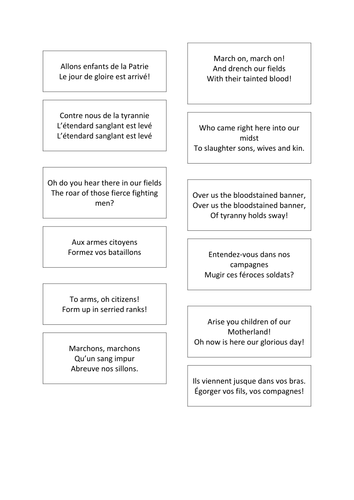


This lesson teaches students about the French Revolution and how a Fête Nationale/ Bastille Day/ Le 14 juillet is celebrated. It uses colourful slides, images and animations, 3 YouTube links, matching cards and karaoke! A fun end of term lesson!
Slide 2 states the objective: To learn facts and vocabulary related to La Révolution Française and La Fête Nationale!
All: Will learn 7 new facts and French words.
Most: Will learn 9 .
Some: Will learn 10+ .
Slide 3 presents the following vocabulary:
Le clergé
La noblesse
Le Tiers-État
Le roi
La reine
La Bastille (une prison)
La guillotine
Le Tricolore
It is differentiated: All: Match the French and the picture (there are some English words to help!).
Most: Perfect Pronunciation Challenge!
Some: Share what you know about La Révolution Française.
Slides 4 – 11 show each word with images and animations so you can drill the new vocabulary.
Slide 12 has all the pictures for each new word.
Then there is graded questioning:
Slides 13 – 20 show an image and provide 2 possible answers.
Slides 21- 30 are “What’s missing?” slides.
Slide 30 is to be used in conjunction with the French worksheet and the YouTube video (in English) The French Revolution In a Nutshell (2 mins 50 secs) which is a cartoon-style clear and concise summary – really fun!
Then the students watch the video:
All: Complete Exercise A.
Most: AND Exercise B.
Some: AND note down any additional facts and French vocabulary.
* The answers are on the first 2 pages of the PDF.
Extract examples of questions:
A. Cochez les choses que vous voyez:
le Tricolore un canon le monde Le clergé la noblesse le Tiers-État
B. Choisissez la bonne réponse:
1. Avant la Révolution il y avait trois rangs :
A. La reine, le roi et le Tiers-État.
B. Le clergé, la noblesse et le Tiers-État.
C. Le roi, le clergé et la noblesse.
Slide 32 states: Pour fêter La Fête Nationale il y a des défilés militaires. Le défilé le plus célèbre a lieu sur l’Avenue des Champs-Élysées.
Le soir il y a des feux d’artifice, des concerts et des bals.
And there is a link to an English language commentary of Bastille Day celebrations on YouTube (1 min 34 secs).
Slide 33 explains the Marseillaise and sets out the task (using English and French matching cards):
Slide 34 has the Marseillaise in English and French.
Slide 35 is a Marseillaise Karaoke slide and links to YouTube.
Finally Slide 36 provides time for reflection.
I hope you enjoy these resources!
Slide 2 states the objective: To learn facts and vocabulary related to La Révolution Française and La Fête Nationale!
All: Will learn 7 new facts and French words.
Most: Will learn 9 .
Some: Will learn 10+ .
Slide 3 presents the following vocabulary:
Le clergé
La noblesse
Le Tiers-État
Le roi
La reine
La Bastille (une prison)
La guillotine
Le Tricolore
It is differentiated: All: Match the French and the picture (there are some English words to help!).
Most: Perfect Pronunciation Challenge!
Some: Share what you know about La Révolution Française.
Slides 4 – 11 show each word with images and animations so you can drill the new vocabulary.
Slide 12 has all the pictures for each new word.
Then there is graded questioning:
Slides 13 – 20 show an image and provide 2 possible answers.
Slides 21- 30 are “What’s missing?” slides.
Slide 30 is to be used in conjunction with the French worksheet and the YouTube video (in English) The French Revolution In a Nutshell (2 mins 50 secs) which is a cartoon-style clear and concise summary – really fun!
Then the students watch the video:
All: Complete Exercise A.
Most: AND Exercise B.
Some: AND note down any additional facts and French vocabulary.
* The answers are on the first 2 pages of the PDF.
Extract examples of questions:
A. Cochez les choses que vous voyez:
le Tricolore un canon le monde Le clergé la noblesse le Tiers-État
B. Choisissez la bonne réponse:
1. Avant la Révolution il y avait trois rangs :
A. La reine, le roi et le Tiers-État.
B. Le clergé, la noblesse et le Tiers-État.
C. Le roi, le clergé et la noblesse.
Slide 32 states: Pour fêter La Fête Nationale il y a des défilés militaires. Le défilé le plus célèbre a lieu sur l’Avenue des Champs-Élysées.
Le soir il y a des feux d’artifice, des concerts et des bals.
And there is a link to an English language commentary of Bastille Day celebrations on YouTube (1 min 34 secs).
Slide 33 explains the Marseillaise and sets out the task (using English and French matching cards):
Slide 34 has the Marseillaise in English and French.
Slide 35 is a Marseillaise Karaoke slide and links to YouTube.
Finally Slide 36 provides time for reflection.
I hope you enjoy these resources!
Something went wrong, please try again later.
would like to have more basic information included to scaffold the slides. would be better for revision rather than an initial presentation.
Thank you for publishing your resource. It has been selected to be featured in <a href="https://www.tes.com/teaching-resources/blog/celebrating-bastille-day"> a post</a> on the <a href="https://www.tes.com/teaching-resources/blog">Tes Resources blog</a>.
Report this resourceto let us know if it violates our terms and conditions.
Our customer service team will review your report and will be in touch.
£4.00
